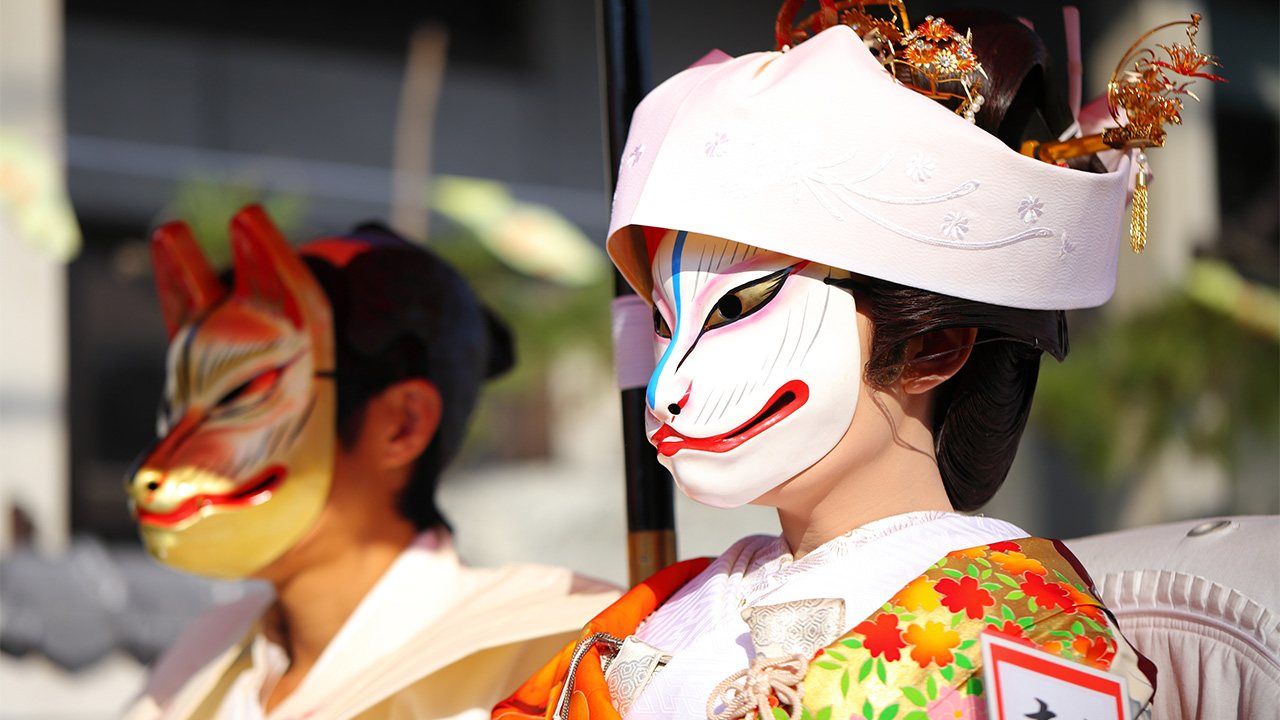
Foxy Lady, Foxy “Yōkai”: How Japan’s “Kitsune” Bewitched the World
Culture History- English
- 日本語
- 简体字
- 繁體字
- Français
- Español
- العربية
- Русский
In March 2022, the cracking of a boulder in the northern Tochigi town of Nasu called the Sesshō-seki, or “Life-Taking Stone,” made headlines around the world. Science tells us it shattered due to water seeping into an existing crack and freezing. Local folklore had a different explanation. This stone is said to be the final resting place of a yōkai—a nine-tailed fox, to be precise.
Timeless Fox Legends
Late in the Heian era (794–1185), it is said, Tamamo no Mae, favorite courtesan of the Emperor Toba, was revealed to be a nine-tailed fox from the Asian continent, where she had laid waste to numerous kingdoms. Shape-shifting into the form of a beautiful woman, she seduced the emperor in an attempt to destroy the country. Unmasked by the onmyōji shaman Abe no Yasunari, Tamamo no Mae fled to the plains of Nasu in Shimotsuke, now Tochigi Prefecture, where she was slain by the warriors Miuranosuke and Kazunosuke.
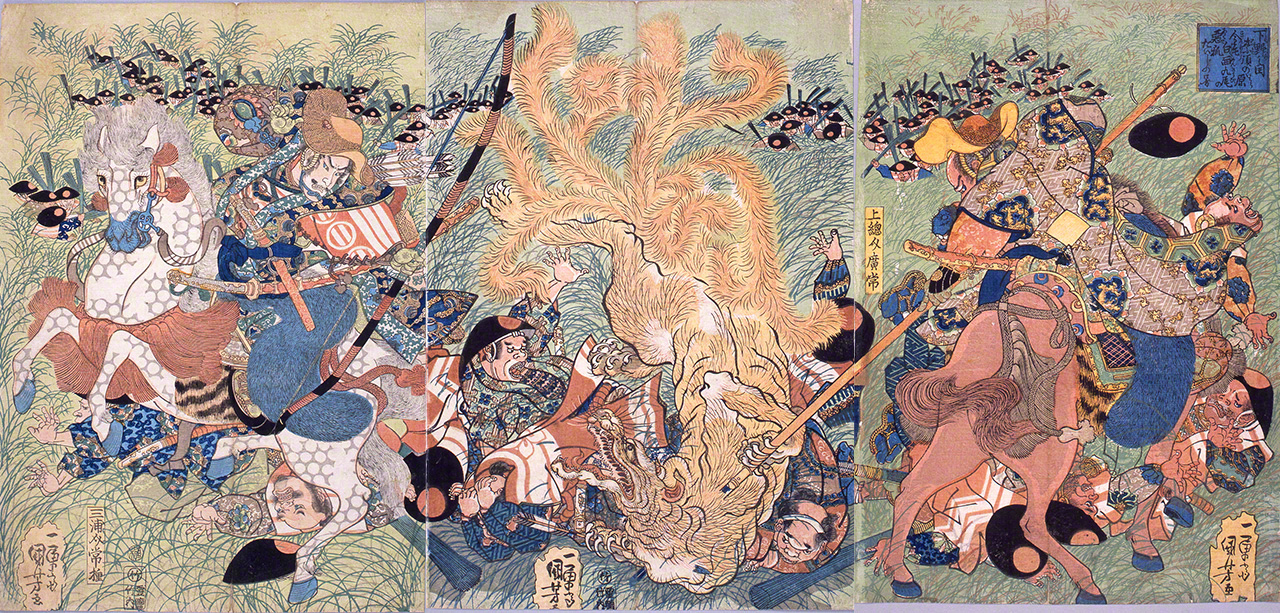
Shimotsuke no kuni Nasu no hara kinmō hakumen kyūbi no akko taiji no zu (The Defeat of the Evil Nine-Tailed Fox on Nasu Moor in Shimotsuke Province), Utagawa Kuniyoshi, 1830. (Courtesy of the Hyōgo Prefectural Museum of History)
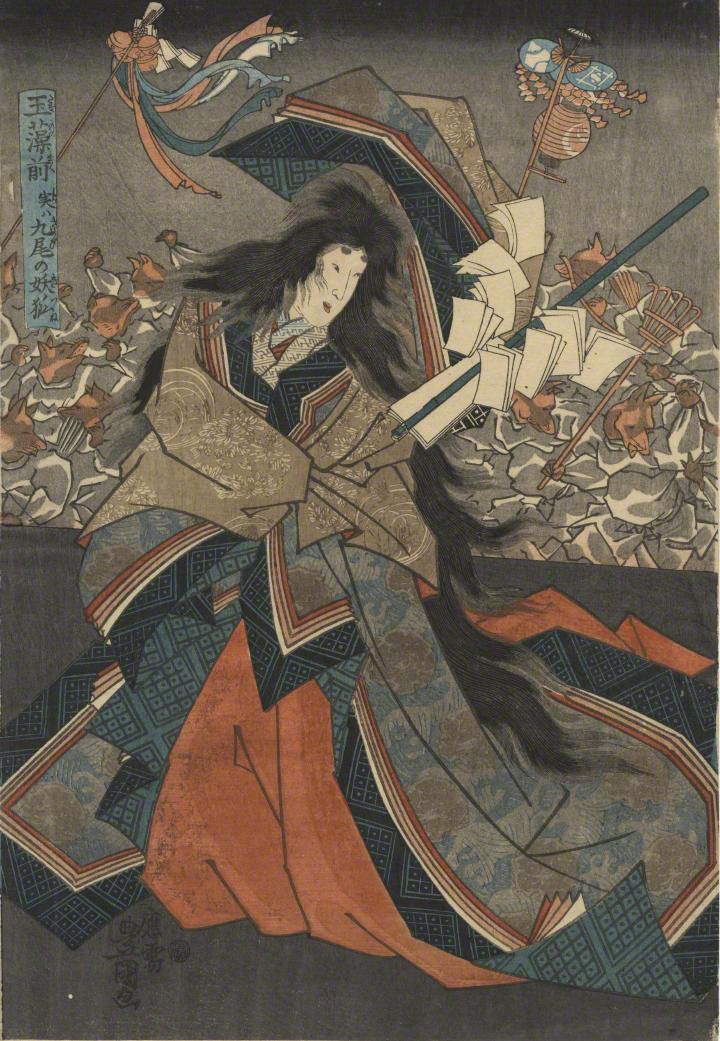
Tamamo no Mae, as pictured in Abe no Yasunari chōbuku yōkai zu (Abe no Yasunari Uses a Mirror to Reveal Tamamo no Mae’s True Form as a Nine-tailed Fox). (Courtesy of the International Research Center for Japanese Studies)
The body of the nine-tailed fox turned to stone, emitting poison gases that killed any who dared approach. Such was the terrifying tale of the Life-Taking Stone, until the Muromachi era (1333–1568), when a brave monk named Gennō smashed it, releasing the soul trapped within and draining the stone of its power. The tool he used, a sort of bush hammer, is known by carpenters as a gennō to this very day.
The source of the legend seems to trace back to the fact that dead birds and animals have been seen around the Life-Taking Stone. Sitting as it does on the slopes of the volcanically active Mount Chausu, it is surrounded by fumaroles that can release toxic gases. When news of the Life-Taking Stone’s cracking hit social media, it was spun as the escape of a great yōkai nine-tailed fox and quickly went viral. However, this take was mistaken. The Life-Taking Stone represents not a prison, but rather the remains of a yōkai fox. And besides, it was already smashed by Gennō almost seven hundred years previous, so even according to legend there was never any danger of a resurrection.

Nasu’s tourist ambassador Kyūbī, a name signifying “nine tails.” (Courtesy of the Nasu Municipal Tourist Information Center)
Popular in Popular Culture
In recent years the nine-tailed fox has emerged as a popular character in manga, anime, and video games, where it is generally treated as a being of great power. Oda Eiichiro’s One Piece features a pirate character named Catarina Devon who is said to be a nine-tailed fox. The eponymous protagonist of Kishimoto Masashi’s Naruto is inhabited by the spirit of a nine-tailed fox. There is a Pokémon called Ninetales, and a nine-tailed fox in the Yōkai Watch series as well.
In spite of its popularity in Japanese pop culture, the nine-tailed fox legend, and the concept of foxes possessing supernatural powers in general, originates not in Japan but in China.
In Japan’s oldest literature, such as the eighth-century Kojiki (Records of Ancient Matters), Nihonshoki (The Chronicle of Japan), and various fudoki manuscripts describing tales and histories of local areas, there is little mention of foxes. They contain stories of certain animals that possess mysterious powers, or serve as familiars of the gods, but the fox is not among them. They discuss snakes, deer, boars, wolves, and mysterious creatures known as wani (generally held to be sharks), with stories of snake-gods being particularly numerous. All the above texts contain legends of snake-gods shape-shifting into men and seducing human women.
However, Japan’s oldest collection of Buddhist parables, the 823 Nihon ryōiki (Record of Miraculous Events in Japan), contains stories of shape-shifting foxes and of foxes possessing people. Stories of fox yōkai were already well established by the Later Han Dynasty of China (25–220 CE), growing in number after the Wei and Jin Dynasties (220–420 CE). It seems this is how fox legends entered Japan, along with the import of Buddhism, becoming firmly cemented in local lore by the ninth century.
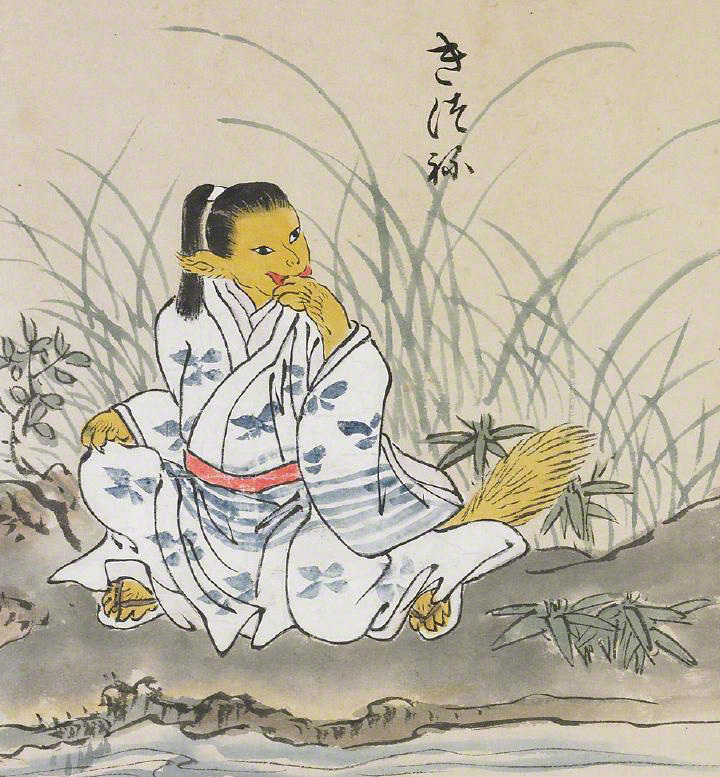
A fox from the late Edo-period Bakemono tsukushi emaki (An Illustrated Scroll of Shape-Shifters). (Courtesy of the International Research Center for Japanese Studies)
The Record of Miraculous Events in Japan contains a story of a snake being treated as a deity, but it does not transform into a human. A woman offers to become a snake’s wife to save a frog, but the snake is destroyed when she affirms her Buddhist faith. In contrast, another story tells of a fox shape-shifting into the form of a woman, marrying a man, and even bearing his child. The roles of snake and fox seem to have reversed.
In the eleventh to twelfth centuries, foxes started to be worshipped as deities in Japan. In the fourteenth century, they became intertwined with Inari, a deity of agriculture. The snake, long worshipped as a bringer of fortune by farmers to this point, essentially found its role usurped by the fox.
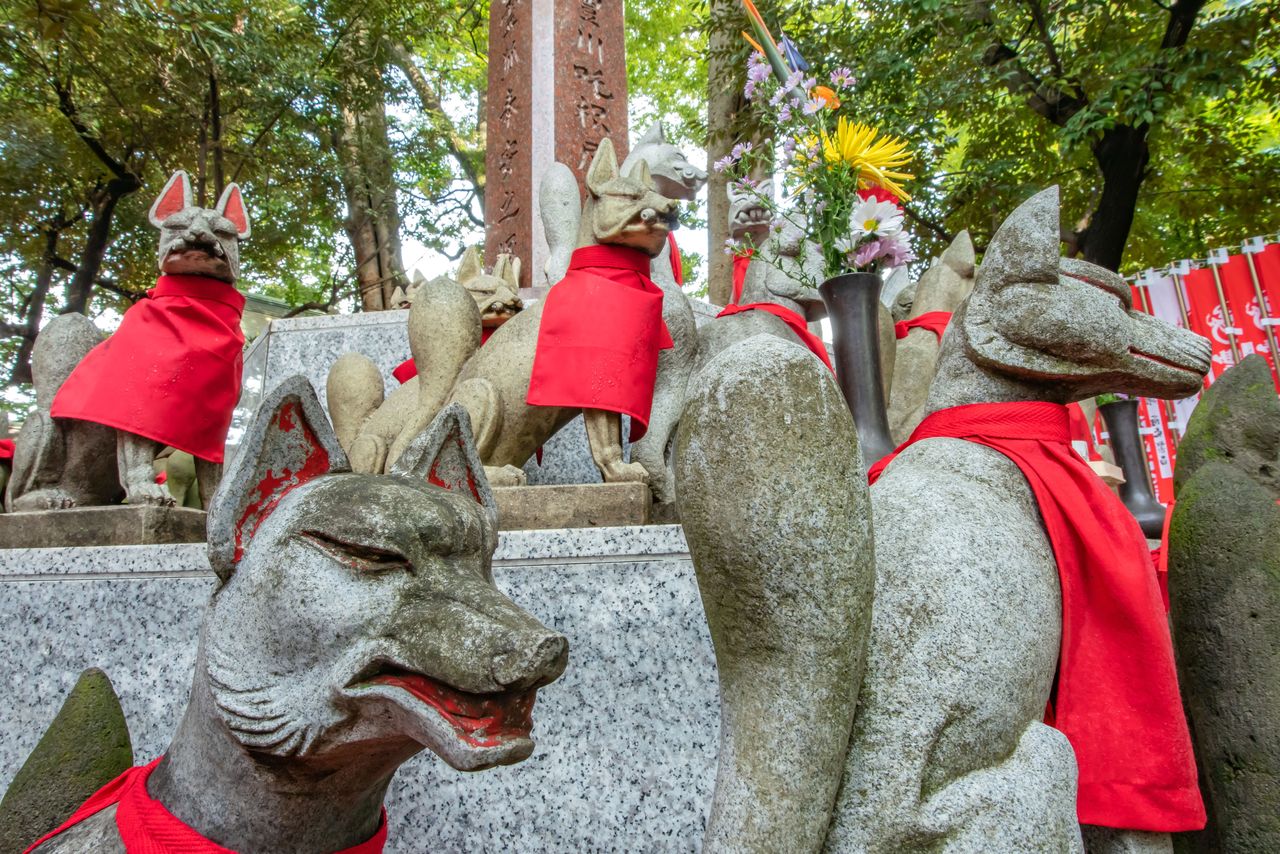
Foxes venerated at Toyokawa Inari Betsuin, Akasaka, Tokyo. (© Pixta)
Fearsome Fox Phenomena
At the same time, stories spread of scary yōkai foxes that took human form to trick people, or even take over their mind and soul. All sorts of inexplicable phenomena came to be attributed to foxes, with phrases like “tricked by a fox” and “fox-possession” entering the popular Japanese lexicon.
One of the more charming examples of this is how a sudden rain shower out of the blue on a sunny day came to be called “a fox wedding.” Originally, this phrase was associated with the phenomena of seeing glowing lights in far-off mountains. The sight of mysterious lights in places where no human would normally be gave rise to the idea that foxes were holding wedding processions there.
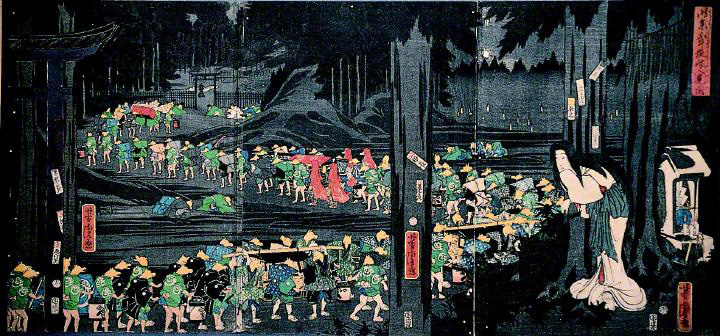
Tokimairi hakarazu mo kitsune no yomeiri o miru zu (Watching a Fox Wedding Procession). (Courtesy of the International Research Center for Japanese Studies)
Before long, the phenomenon of strange lights came to be called kitsune-bi, literally “foxfire.” In what is considered Japan’s oldest manga, the twelfth-century Chōjū jinbutsu giga (Anthropomorphic Animals at Play), you can see illustrations of foxes with tails whose tips are aflame like torches. In the Konjaku monogatari, a collection of Buddhist parables from the same time period, strange lights are described as the work of foxes, which hints that the foxfire idea dates back to this era.
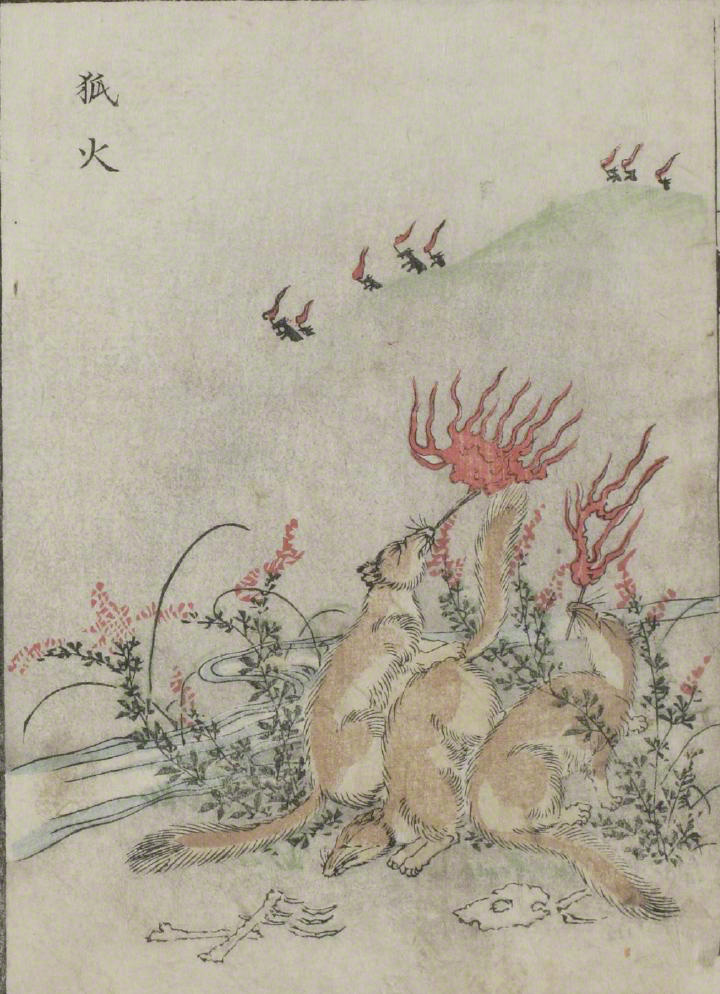
Foxfire from Kaibutsu ehon (Monsters Illustrated). (Courtesy of the International Research Center for Japanese Studies)
Foxy Ladies
The idea that foxes might transform into beautiful ladies and bewitch men may have originated in China as well. In Chinese lore the world is divided into yin and yang energies. Foxes are seen as possessing yin energy, as are human women. This seems to have given rise to the idea that foxes (of either sex) can shape-shift into women.
Tamamo no Mae could be called the textbook example of this idea. However, the concept that she was a nine-tailed fox in particular is of surprisingly recent origin, dating only back to the Edo period (1603–1868). In early tellings, she was a two-tailed fox. Interestingly, Japanese folklore tells of yōkai cats called nekomata, or “fork-tailed cats,” and this seems to have inflected the Tamamo no Mae legend around this time.
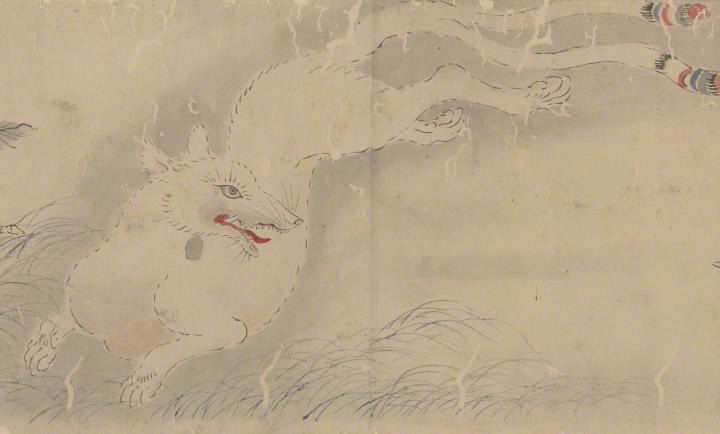
A two-tailed version on the Tamamo no Mae monogatari emaki (Illustrated Scroll of the Tamamo no Mae Tale). (Courtesy of the International Research Center for Japanese Studies)
In Chinese lore, Daji, favorite consort of King Zhou of Shang (r. 1075–1046 BCE), was a nine-tailed fox hellbent on destroying his reign. This story entered Japan in translation in the mid-Edo era, entwining itself with existing stories of Tamamo no Mae to transform her from a two- into a nine-tailed fox in the popular imagination. When you think about it, this means that the stories of the nine-tailed fox seen so often in Japanese manga, anime, and games represent a form of international cultural exchange.
(Originally published in Japanese. Banner image: A fox wedding procession from a festival held every November 3 at Hanaoka Fukutoku Inarisha Shrine in Kudamatsu, Yamaguchi Prefecture. © Pixta.)